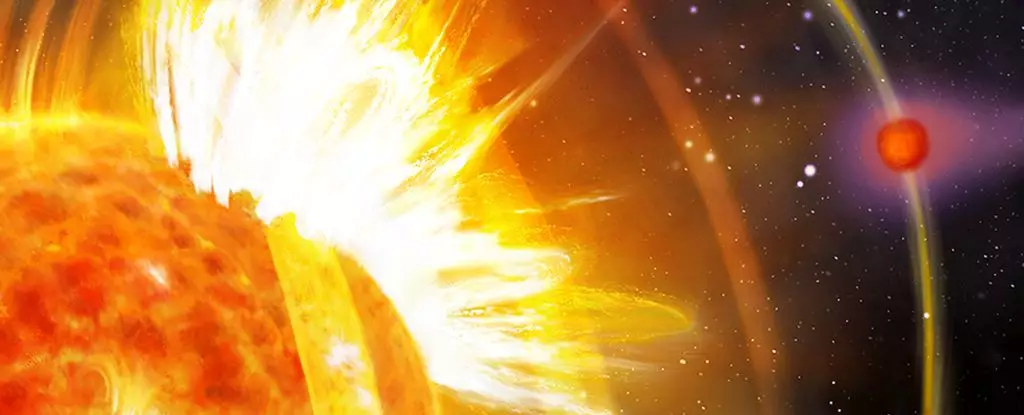In the vast expanse of the universe, stars and planets are often perceived as isolated entities—celestial bodies with their own independent behaviors. However, recent groundbreaking astronomical observations challenge this conventional wisdom by exposing a dynamic and intimate interaction between a planet and its host star. This discovery reveals that a planet situated extremely close to its star can actively influence stellar activity, igniting powerful flares that drastically alter both bodies’ evolution. Such findings compel us to reconsider the simplistic models of star-planet independence and recognize the universe as a more interconnected tapestry, where even the smallest players can exert profound influence on their cosmic environment.
This revelation emerges from observations of a young, Sun-like star, HIP 67522, accompanied by a modest yet influential exoplanet. The revelation is revolutionary: the planet’s magnetic field and orbital dance appear to stir the star’s magnetic engine, causing relentless flare-ups. These stellar outbursts aren’t merely cosmetic—they have severe consequences, stripping the planet’s atmospheric shield and accelerating its decay. This isn’t a distant, theoretical possibility; it’s a tangible phenomenon, observed and studied over several years, highlighting the intricate ballet between stellar magnetic fields and planetary influences.
The significance of this interaction extends beyond the immediate system. It signals a paradigm shift in astrophysics, emphasizing that planets are not passive recipients in their stellar systems—they can, under certain circumstances, act as catalysts for stellar phenomena. This layered complexity unveils an ecosystem where celestial bodies are engaged in a subtle yet powerful conversation, shaping each other’s fates in ways previously thought impossible. As we identify more such systems, the broader implications for planetary stability, habitability, and even the evolution of planetary systems come sharply into focus.
The Implications for Planetary Fate and Habitability
The case of HIP 67522b is not merely fascinating; it serves as a stark warning about the fragility of young, close-orbiting planets. As the planet’s magnetic interactions incite intense stellar flares, its atmosphere faces relentless erosion—an energy assault capable of transforming a lush, potentially life-supporting world into a desolate, barren remnant. The planet, which measures roughly the size of Jupiter but embodies only about 5 percent of its mass, experiences a relentless barrage of radiation—amplified by the star’s magnetic fury—leading to atmospheric heating and leakage.
This atmospheric loss is exacerbated by the proximity of the planet, orbiting its star in every 6.95 days—an incredibly rapid pace that prevents its atmosphere from stabilizing. Over time, this could mean that the planet is destined to become a smaller, more dense core, akin to a Neptune or even a super-Earth, devoid of the thick, puffy atmosphere it might have once had. Such processes emphasize how powerful stellar activity, especially when triggered by planetary influences, can accelerate planetary decay, significantly impacting potential habitability and surface conditions.
Furthermore, the dynamic interaction hints at broader cosmic patterns. Many exoplanets orbit within dangerously close proximity to their stars, particularly in young planetary systems still tumultuous from their formation. These close orbits, once considered merely a curiosity, are now recognized as potential catalysts for fierce stellar activity—flares that can sterilize or strip planets of their atmospheres, rendering them inhospitable. This challenges the optimistic view that planets in such orbits might still host life; instead, it suggests that their very closeness could doom them to a grim evolutionary path, internalized by magnetic turmoil and relentless radiation.
The pursuit to find more of these systems will reshape our understanding of planetary evolution, urging scientists to look beyond the traditional metrics of planet habitability. It might turn out that some planets in seemingly promising zones are outright unlivable due to their magnetic and atmospheric vulnerabilities triggered by their stars’ unanticipated reactions.
Forging New Frontiers in Stellar and Planetary Science
What excites many astronomers about this discovery is the potential for a new branch of astrophysics—where star-planet magnetic interactions become a key focus in understanding cosmic dynamics. The case of HIP 67522 and its influential planet opens the door to studying how common such phenomena might be. Could thousands of young, close-orbiting planets be actively shaping their stars’ behavior? If so, what does this mean for our search for habitable worlds beyond the solar system?
The ability to detect and analyze these interactions is still in its infancy, but the implications are profound. Recognizing that a planet can provoke energetic stellar flares forces a reevaluation of existing models of stellar stability and planetary atmospheric retention. Moreover, it suggests that when searching for life-friendly worlds, scientists must account for these magnetic might and their potential to rapidly strip planets of their life-sustaining atmospheres.
This trend also hints at the possibility that star-planet interactions could be more widespread than previously believed. If many young systems harbor planets capable of triggering intense flares, then the lifecycle of planets and stars is more intertwined than ever imagined. Every flare, every atmospheric leak, is a chapter in an ongoing cosmic story—one where the line between celestial bodies blurs into a partnership of mutual influence, rather than mere coexistence.
The journey ahead involves advanced observation techniques, detailed modeling, and perhaps a recalibration of what makes a planet truly habitable. As astronomers hunt for signs of life and planetary stability, considering these magnetic interactions will either be an obstacle or a crucial clue in understanding the complex dance that shapes worlds across the galaxy. This is a frontier that promises not only scientific discovery but a deepened appreciation for the universe’s intricate and interconnected nature.


Leave a Reply